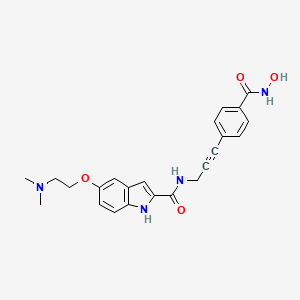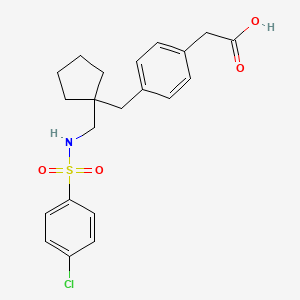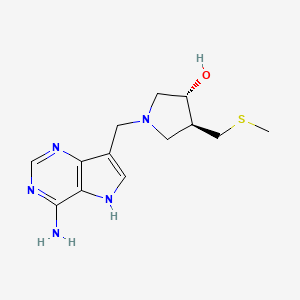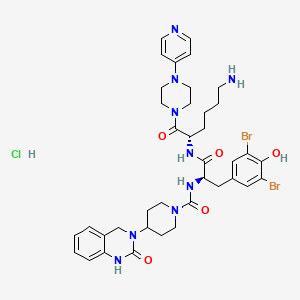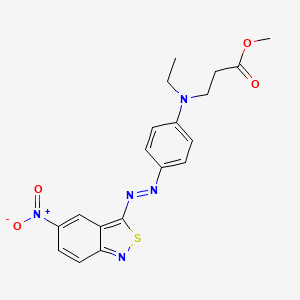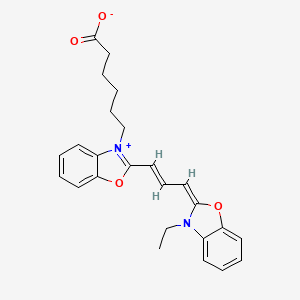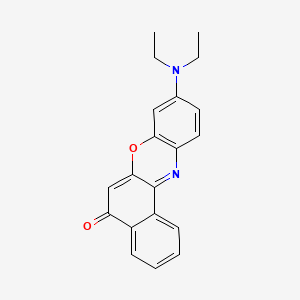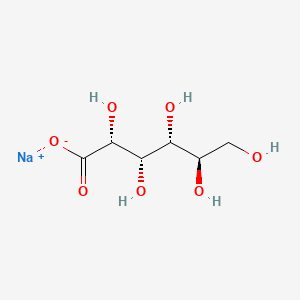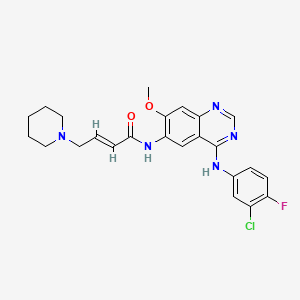
Dacomitinib
Vue d'ensemble
Description
Dacomitinib est un médicament principalement utilisé pour le traitement du carcinome bronchique non à petites cellules (CBNPC). Il est commercialisé sous le nom de marque Vizimpro. This compound est un inhibiteur sélectif et irréversible de la famille des récepteurs du facteur de croissance épidermique (EGFR), qui comprend EGFR/HER1, HER2 et HER4 . Il a été développé par Pfizer Inc. et approuvé par la FDA en septembre 2018 .
Applications De Recherche Scientifique
Dacomitinib has several scientific research applications, particularly in the fields of chemistry, biology, medicine, and industry :
Chemistry: Used as a model compound for studying the synthesis and reactions of quinazoline derivatives.
Biology: Investigated for its effects on cellular signaling pathways and its role in inhibiting the EGFR family.
Medicine: Primarily used for the treatment of NSCLC with EGFR mutations.
Industry: Employed in the development of new pharmaceutical formulations and drug delivery systems.
Mécanisme D'action
Target of Action
Dacomitinib is a second-generation, irreversible tyrosine kinase inhibitor (TKI) that primarily targets the epidermal growth factor receptor (EGFR) family . The EGFR family plays a crucial role in cell proliferation and survival, and its overexpression or mutation is often associated with various types of cancers, including non-small cell lung cancer (NSCLC) .
Mode of Action
This compound works by irreversibly binding to the ATP domain of the EGFR family kinase domains . This binding inhibits the kinase activity of the EGFR family, which includes EGFR/HER1, HER2, and HER4, as well as certain EGFR activating mutations . By inhibiting these kinases, this compound prevents the activation of downstream signaling pathways that promote cell proliferation and survival .
Biochemical Pathways
The primary biochemical pathway affected by this compound is the EGFR signaling pathway. When this compound binds to the EGFR family kinases, it inhibits their activity, thereby preventing the activation of downstream signaling pathways that promote cell proliferation and survival . This inhibition can lead to cell cycle arrest and apoptosis, thereby inhibiting the growth of cancer cells .
Pharmacokinetics
This compound exhibits good bioavailability of over 50% and has a long half-life . It is metabolized primarily by CYP2D6 and CYP3A4 enzymes . The drug and its metabolites are primarily excreted in the feces . These ADME properties contribute to the drug’s effectiveness and its ability to maintain therapeutic concentrations in the body .
Result of Action
The molecular effect of this compound’s action is the inhibition of EGFR family kinases, which leads to the suppression of downstream signaling pathways that promote cell proliferation and survival . On a cellular level, this results in cell cycle arrest and apoptosis, leading to the inhibition of cancer cell growth . Clinical studies have shown that this compound can effectively inhibit the growth of cancer cells, particularly in patients with EGFR mutation-positive NSCLC .
Action Environment
The efficacy and stability of this compound can be influenced by various environmental factors. For instance, co-administration with certain medications, such as H2-receptor antagonists, can affect the exposure and efficacy of this compound . Additionally, genetic factors such as the presence of specific EGFR mutations can influence the drug’s efficacy . It’s also worth noting that the drug’s side effects can vary among individuals, potentially due to differences in individual health status, genetic factors, or other environmental influences .
Analyse Biochimique
Biochemical Properties
Dacomitinib interacts with the epidermal growth factor receptor (EGFR) family kinase domains . It binds irreversibly at the ATP domain of these receptors, inhibiting their activity . The major circulating metabolite of this compound is an O-desmethyl this compound form named PF-05199265 .
Cellular Effects
This compound has shown to have significant effects on various types of cells, particularly cancer cells. It blocks proteins on cancer cells that encourage the cancer to grow . These proteins are called epidermal growth factor receptors (EGFR). If a cancer has these receptors, it is EGFR positive . This compound also increases the inhibition of the EGFR kinase domain as well as the activity in cell lines harboring resistance mutations such as T790M .
Molecular Mechanism
This compound works by selectively and irreversibly binding to the kinase domains EGFR/HER1, HER2, and HER4 . This inhibits tyrosine kinase autophosphorylation, resulting in a reduction of tumor growth and tumor regression .
Temporal Effects in Laboratory Settings
In laboratory settings, the effects of this compound have been observed over time. For instance, a study showed that this compound showed good activity and manageable toxicity in NSCLC patients with uncommon EGFR mutations .
Dosage Effects in Animal Models
In animal studies, this compound has shown to induce embryo-fetal toxicity, as demonstrated by an increased incidence of a post-implantation loss and reduced fetal body weight at doses resulting in exposures near the exposure at the 45mg human dose .
Metabolic Pathways
This compound undergoes oxidative and conjugative metabolism, marked mainly by the activity of glutathione and cytochrome P450 enzymes . After metabolism, its major circulating metabolite is an O-desmethyl this compound form named PF-05199265 .
Transport and Distribution
This compound is absorbed and distributed in the body, and this process does not seem to be affected by food or the consumption of antacids . The peak plasma concentration after a dosage of 45 mg for 4 days is of 104 ng/ml .
Subcellular Localization
As this compound binds to these receptors, it is likely to be localized at the cell membrane where these receptors are present .
Méthodes De Préparation
La préparation du dacomitinib implique plusieurs voies de synthèse et conditions de réaction. Une méthode comprend les étapes suivantes :
Réaction de méthoxylation : La N-(3-chloro-4-fluorophényl)-7-fluoro-6-nitro-4-quinazolinamine est soumise à une méthoxylation dans un système alcalin/méthanol pour obtenir la N-(3-chloro-4-fluorophényl)-7-méthoxy-6-nitroquinazolinamine-4-amine.
Réaction de réduction : Le composé obtenu à partir de la réaction de méthoxylation est ensuite réduit en utilisant de l'hydrate d'hydrazine pour obtenir la N-(3-chloro-4-fluorophényl)-7-méthoxy-6-aminoquinazoline-4-amine.
Réaction de condensation : Ce composé est ensuite condensé avec un composé de chlorure d'acyle (2E)-4-(1-pipéridyl)-2-buténoïque acide chlorhydrate dans un solvant de N-méthylpyrrolidone pour obtenir un produit brut.
Recristallisation : Le produit brut est raffiné dans une solution d'éthanol-eau pour obtenir du this compound.
Cette méthode évite l'utilisation de grandes quantités de solvant, ce qui la rend plus respectueuse de l'environnement et adaptée à la production industrielle .
Analyse Des Réactions Chimiques
Dacomitinib subit plusieurs types de réactions chimiques, notamment l'oxydation, la réduction et la substitution . Les réactifs et conditions courants utilisés dans ces réactions comprennent :
Oxydation : Implique l'utilisation d'oxydants tels que le peroxyde d'hydrogène ou le permanganate de potassium.
Réduction : Utilise généralement des réducteurs comme l'hydrate d'hydrazine.
Substitution : Utilise divers agents halogénants et nucléophiles.
Les principaux produits formés à partir de ces réactions comprennent le O-desméthyl this compound, qui est un métabolite formé par le métabolisme oxydatif par les enzymes du cytochrome P450 .
Applications de la recherche scientifique
This compound a plusieurs applications de recherche scientifique, en particulier dans les domaines de la chimie, de la biologie, de la médecine et de l'industrie :
Chimie : Utilisé comme composé modèle pour étudier la synthèse et les réactions des dérivés de la quinazoline.
Biologie : Enquêté pour ses effets sur les voies de signalisation cellulaire et son rôle dans l'inhibition de la famille EGFR.
Médecine : Principalement utilisé pour le traitement du CBNPC avec des mutations EGFR.
Industrie : Utilisé dans le développement de nouvelles formulations pharmaceutiques et de systèmes d'administration de médicaments.
Mécanisme d'action
This compound exerce ses effets en inhibant de manière irréversible l'activité kinase de la famille EGFR humaine (EGFR/HER1, HER2 et HER4) et certaines mutations d'activation EGFR (délétion de l'exon 19 et substitution L858R de l'exon 21) . En se liant au site de liaison à l'ATP de ces récepteurs, this compound empêche l'autophosphorylation du récepteur et la signalisation en aval, ce qui conduit à l'inhibition de la croissance et de la prolifération des cellules cancéreuses .
Comparaison Avec Des Composés Similaires
Dacomitinib est souvent comparé à d'autres inhibiteurs de l'EGFR tels que l'afatinib et le gefitinib . Voici quelques points clés de comparaison :
Afatinib : Comme le this compound, l'afatinib est un inhibiteur irréversible de l'EGFR. Les deux médicaments sont utilisés pour le traitement de première intention du CBNPC positif pour la mutation EGFR.
Gefitinib : Gefitinib est un inhibiteur réversible de l'EGFR.
Ces comparaisons mettent en évidence le caractère unique du this compound en termes de sa liaison irréversible et de son efficacité dans le traitement des mutations EGFR rares.
Propriétés
IUPAC Name |
(E)-N-[4-(3-chloro-4-fluoroanilino)-7-methoxyquinazolin-6-yl]-4-piperidin-1-ylbut-2-enamide | |
|---|---|---|
| Source | PubChem | |
| URL | https://pubchem.ncbi.nlm.nih.gov | |
| Description | Data deposited in or computed by PubChem | |
InChI |
InChI=1S/C24H25ClFN5O2/c1-33-22-14-20-17(24(28-15-27-20)29-16-7-8-19(26)18(25)12-16)13-21(22)30-23(32)6-5-11-31-9-3-2-4-10-31/h5-8,12-15H,2-4,9-11H2,1H3,(H,30,32)(H,27,28,29)/b6-5+ | |
| Source | PubChem | |
| URL | https://pubchem.ncbi.nlm.nih.gov | |
| Description | Data deposited in or computed by PubChem | |
InChI Key |
LVXJQMNHJWSHET-AATRIKPKSA-N | |
| Source | PubChem | |
| URL | https://pubchem.ncbi.nlm.nih.gov | |
| Description | Data deposited in or computed by PubChem | |
Canonical SMILES |
COC1=C(C=C2C(=C1)N=CN=C2NC3=CC(=C(C=C3)F)Cl)NC(=O)C=CCN4CCCCC4 | |
| Source | PubChem | |
| URL | https://pubchem.ncbi.nlm.nih.gov | |
| Description | Data deposited in or computed by PubChem | |
Isomeric SMILES |
COC1=C(C=C2C(=C1)N=CN=C2NC3=CC(=C(C=C3)F)Cl)NC(=O)/C=C/CN4CCCCC4 | |
| Source | PubChem | |
| URL | https://pubchem.ncbi.nlm.nih.gov | |
| Description | Data deposited in or computed by PubChem | |
Molecular Formula |
C24H25ClFN5O2 | |
| Source | PubChem | |
| URL | https://pubchem.ncbi.nlm.nih.gov | |
| Description | Data deposited in or computed by PubChem | |
DSSTOX Substance ID |
DTXSID50149493 | |
| Record name | Dacomitinib | |
| Source | EPA DSSTox | |
| URL | https://comptox.epa.gov/dashboard/DTXSID50149493 | |
| Description | DSSTox provides a high quality public chemistry resource for supporting improved predictive toxicology. | |
Molecular Weight |
469.9 g/mol | |
| Source | PubChem | |
| URL | https://pubchem.ncbi.nlm.nih.gov | |
| Description | Data deposited in or computed by PubChem | |
Solubility |
<1 mg/mL | |
| Record name | Dacomitinib | |
| Source | DrugBank | |
| URL | https://www.drugbank.ca/drugs/DB11963 | |
| Description | The DrugBank database is a unique bioinformatics and cheminformatics resource that combines detailed drug (i.e. chemical, pharmacological and pharmaceutical) data with comprehensive drug target (i.e. sequence, structure, and pathway) information. | |
| Explanation | Creative Common's Attribution-NonCommercial 4.0 International License (http://creativecommons.org/licenses/by-nc/4.0/legalcode) | |
Mechanism of Action |
Dacomitinib is an irreversible small molecule inhibitor of the activity of the human epidermal growth factor receptor (EGFR) family (EGFR/HER1, HER2, and HER4) tyrosine kinases. It achieves irreversible inhibition via covalent bonding to the cysteine residues in the catalytic domains of the HER receptors. The affinity of dacomitinib has been shown to have an IC50 of 6 nmol/L. The ErbB or epidermal growth factor (EGF) family plays a role in tumor growth, metastasis, and treatment resistance by activating downstream signal transduction pathways such as such as Ras-Raf-MAPK, PLCgamma-PKC-NFkB and PI3K/AKT through the tyrosine kinase-driven phosphorylation at the carboxy-terminus. Around 40% of cases show amplification of EGFR gene and 50% of the cases present the _EGFRvIII_ mutation which represents a deletion that produces a continuous activation of the tyrosine kinase domain of the receptor. | |
| Record name | Dacomitinib | |
| Source | DrugBank | |
| URL | https://www.drugbank.ca/drugs/DB11963 | |
| Description | The DrugBank database is a unique bioinformatics and cheminformatics resource that combines detailed drug (i.e. chemical, pharmacological and pharmaceutical) data with comprehensive drug target (i.e. sequence, structure, and pathway) information. | |
| Explanation | Creative Common's Attribution-NonCommercial 4.0 International License (http://creativecommons.org/licenses/by-nc/4.0/legalcode) | |
CAS No. |
1110813-31-4 | |
| Record name | Dacomitinib | |
| Source | CAS Common Chemistry | |
| URL | https://commonchemistry.cas.org/detail?cas_rn=1110813-31-4 | |
| Description | CAS Common Chemistry is an open community resource for accessing chemical information. Nearly 500,000 chemical substances from CAS REGISTRY cover areas of community interest, including common and frequently regulated chemicals, and those relevant to high school and undergraduate chemistry classes. This chemical information, curated by our expert scientists, is provided in alignment with our mission as a division of the American Chemical Society. | |
| Explanation | The data from CAS Common Chemistry is provided under a CC-BY-NC 4.0 license, unless otherwise stated. | |
| Record name | Dacomitinib [USAN:INN] | |
| Source | ChemIDplus | |
| URL | https://pubchem.ncbi.nlm.nih.gov/substance/?source=chemidplus&sourceid=1110813314 | |
| Description | ChemIDplus is a free, web search system that provides access to the structure and nomenclature authority files used for the identification of chemical substances cited in National Library of Medicine (NLM) databases, including the TOXNET system. | |
| Record name | Dacomitinib | |
| Source | DrugBank | |
| URL | https://www.drugbank.ca/drugs/DB11963 | |
| Description | The DrugBank database is a unique bioinformatics and cheminformatics resource that combines detailed drug (i.e. chemical, pharmacological and pharmaceutical) data with comprehensive drug target (i.e. sequence, structure, and pathway) information. | |
| Explanation | Creative Common's Attribution-NonCommercial 4.0 International License (http://creativecommons.org/licenses/by-nc/4.0/legalcode) | |
| Record name | Dacomitinib | |
| Source | EPA DSSTox | |
| URL | https://comptox.epa.gov/dashboard/DTXSID50149493 | |
| Description | DSSTox provides a high quality public chemistry resource for supporting improved predictive toxicology. | |
| Record name | DACOMITINIB ANHYDROUS | |
| Source | FDA Global Substance Registration System (GSRS) | |
| URL | https://gsrs.ncats.nih.gov/ginas/app/beta/substances/2XJX250C20 | |
| Description | The FDA Global Substance Registration System (GSRS) enables the efficient and accurate exchange of information on what substances are in regulated products. Instead of relying on names, which vary across regulatory domains, countries, and regions, the GSRS knowledge base makes it possible for substances to be defined by standardized, scientific descriptions. | |
| Explanation | Unless otherwise noted, the contents of the FDA website (www.fda.gov), both text and graphics, are not copyrighted. They are in the public domain and may be republished, reprinted and otherwise used freely by anyone without the need to obtain permission from FDA. Credit to the U.S. Food and Drug Administration as the source is appreciated but not required. | |
Melting Point |
184-187 ºC | |
| Record name | Dacomitinib | |
| Source | DrugBank | |
| URL | https://www.drugbank.ca/drugs/DB11963 | |
| Description | The DrugBank database is a unique bioinformatics and cheminformatics resource that combines detailed drug (i.e. chemical, pharmacological and pharmaceutical) data with comprehensive drug target (i.e. sequence, structure, and pathway) information. | |
| Explanation | Creative Common's Attribution-NonCommercial 4.0 International License (http://creativecommons.org/licenses/by-nc/4.0/legalcode) | |
Retrosynthesis Analysis
AI-Powered Synthesis Planning: Our tool employs the Template_relevance Pistachio, Template_relevance Bkms_metabolic, Template_relevance Pistachio_ringbreaker, Template_relevance Reaxys, Template_relevance Reaxys_biocatalysis model, leveraging a vast database of chemical reactions to predict feasible synthetic routes.
One-Step Synthesis Focus: Specifically designed for one-step synthesis, it provides concise and direct routes for your target compounds, streamlining the synthesis process.
Accurate Predictions: Utilizing the extensive PISTACHIO, BKMS_METABOLIC, PISTACHIO_RINGBREAKER, REAXYS, REAXYS_BIOCATALYSIS database, our tool offers high-accuracy predictions, reflecting the latest in chemical research and data.
Strategy Settings
| Precursor scoring | Relevance Heuristic |
|---|---|
| Min. plausibility | 0.01 |
| Model | Template_relevance |
| Template Set | Pistachio/Bkms_metabolic/Pistachio_ringbreaker/Reaxys/Reaxys_biocatalysis |
| Top-N result to add to graph | 6 |
Feasible Synthetic Routes
Q1: What is the primary mechanism of action of Dacomitinib?
A1: this compound is an irreversible pan-HER tyrosine kinase inhibitor (TKI), forming covalent bonds with the kinase domains of the epidermal growth factor receptor (EGFR) family, including EGFR (HER1), HER2, and HER4. [] This irreversible binding leads to prolonged inhibition of these receptors. [, ]
Q2: What are the downstream effects of this compound's inhibition of EGFR family receptors?
A2: this compound inhibits EGFR signaling, leading to the suppression of downstream pathways such as AKT, STAT3, ERK, and p38. [] It also inhibits the phosphorylation of Bad and, in combination with Paclitaxel, effectively suppresses the expression of Mcl-1. [] In addition, this compound has been shown to reduce the phosphorylation of HER2, EGFR, HER4, AKT, and ERK in sensitive cell lines. []
Q3: Does this compound affect the cellular localization of EGFR family members?
A3: Research suggests that this compound, unlike the dual EGFR/ErbB2 inhibitor Lapatinib, disrupts the membrane localization of EGFR, HER2, and HER3 proteins, potentially contributing to its efficacy. []
Q4: Have computational methods been employed to study this compound?
A4: Yes, pharmacokinetic models, including transit compartment models, have been used to characterize the absorption phase of this compound and quantify the impact of co-administered drugs like Rabeprazole on its pharmacokinetics. []
Q5: How does this compound's irreversible binding mechanism affect its activity compared to reversible EGFR inhibitors?
A5: this compound's irreversible binding to EGFR leads to prolonged inhibition of EGFR signaling compared to reversible inhibitors like Gefitinib and Erlotinib. [, ] This prolonged inhibition is thought to contribute to its potential to overcome resistance mechanisms that develop against first-generation EGFR TKIs. []
Q6: How is this compound administered, and what is its typical dosage regimen?
A6: While this Q&A focuses on scientific aspects, it's important to note that dosing information should always be obtained from relevant prescribing information and healthcare professionals. The research mentions this compound is administered orally, with dosages adjusted based on factors like patient tolerance and clinical response. [, ]
Q7: How is this compound metabolized in the body?
A7: this compound is primarily metabolized by cytochrome P450 (CYP) enzymes, specifically CYP2D6 and CYP2C9. [] This metabolic pathway leads to the formation of its major circulating metabolite, PF-05199265. []
Q8: How does the genetic polymorphism of CYP2D6 affect this compound metabolism?
A9: Research indicates that while this compound's overall exposure is similar among individuals with different CYP2D6 genotypes, the exposure to its metabolite, PF-05199265, is higher in extensive metabolizers compared to intermediate metabolizers. []
Q9: Does this compound interact with other drugs?
A10: Yes, this compound has been shown to interact with several drugs. For example, co-administration with the CYP2D6 inhibitor Trazodone can increase the blood exposure to both drugs. [] Additionally, this compound's strong inhibition of CYP2D6 can impair the metabolism of drugs metabolized by this enzyme, such as Metoprolol, potentially leading to adverse effects. []
Q10: What is the efficacy of this compound in EGFR-mutated NSCLC compared to first-generation EGFR TKIs?
A11: In a randomized phase III trial (ARCHER 1050), this compound demonstrated superior progression-free survival (PFS) and overall survival (OS) compared to Gefitinib in patients with EGFR-mutated NSCLC. []
Q11: Has this compound demonstrated efficacy in preclinical models of other cancer types?
A12: Yes, preclinical studies have shown this compound's antitumor activity in various cancer models, including bladder cancer, breast cancer, and glioblastoma. [, , ] Notably, in HER2-amplified breast cancer models, this compound inhibited growth in cell lines with de novo and acquired resistance to Trastuzumab and maintained activity in those resistant to Lapatinib. []
Q12: Is this compound effective in treating brain metastases in NSCLC?
A13: Clinical observations suggest that this compound can effectively control brain metastases in patients with EGFR-mutated NSCLC, though further prospective studies are needed to confirm this finding. []
Q13: Does this compound demonstrate activity against uncommon EGFR mutations in NSCLC?
A14: While data is still emerging, this compound has shown promising activity in patients with NSCLC harboring major uncommon EGFR mutations, including G719X, S768I, and L861Q. []
Q14: How does this compound compare to Afatinib in NSCLC patients with uncommon EGFR mutations?
A15: A comparative cohort study (AFANDA) found that this compound demonstrated a more favorable activity profile and manageable toxicity compared to Afatinib in NSCLC patients with uncommon EGFR mutations. []
Q15: What are the mechanisms of resistance to this compound?
A16: Although this compound shows promise in overcoming some resistance mechanisms to first-generation EGFR TKIs, resistance can still develop. The emergence of the T790M mutation is one such mechanism, although its occurrence does not appear to differ significantly between this compound and other EGFR TKIs. [, , ]
Q16: Are there any potential biomarkers for predicting this compound's efficacy in GBM?
A17: While EGFRvIII and EGFR ECD mutation status in archival tumors did not predict clinical benefit, RNA signatures in circulating extracellular vesicles (EVs) from patients with GBM showed potential as biomarkers of this compound efficacy. []
Q17: Are there any biomarkers associated with response to this compound in head and neck squamous cell carcinoma (HNSCC)?
A18: In HNSCC, mutations in PIK3CA and PTEN were significantly associated with shorter PFS in patients treated with this compound. [] Additionally, increased gene expression of proinflammatory chemokines and inflammatory response modulators was linked to shorter PFS. []
Q18: What analytical methods are used to detect this compound in biological samples?
A19: Ultra-performance liquid chromatography-tandem mass spectrometry (UPLC-MS/MS) is a commonly used method for quantifying this compound concentrations in biological samples. []
Q19: How is the tissue distribution of this compound investigated?
A20: Immunohistochemistry has been successfully employed to visualize and study the localization and accumulation of this compound in rat intestinal and skin tissues. []
Q20: Are there validated analytical methods for analyzing this compound and its impurities?
A21: Yes, a stability-indicating reverse-phase high-performance liquid chromatography (RP-HPLC) method with UV detection has been developed and validated for analyzing this compound and its related impurities in bulk and oral solid dosage formulations. []
Q21: Does this compound influence the activity of drug-metabolizing enzymes?
A22: Yes, this compound acts as a strong inhibitor of CYP2D6. [, ] This inhibition can potentially lead to drug-drug interactions when co-administered with medications metabolized by CYP2D6.
Q22: Are there other treatment options for EGFR-mutated NSCLC besides this compound?
A23: Yes, other EGFR TKIs like Gefitinib, Erlotinib, and Afatinib are also used in the treatment of EGFR-mutated NSCLC. [, , , ] The choice of treatment depends on various factors, including patient characteristics, mutation type, and treatment history.
Q23: How has the development of this compound contributed to the treatment of EGFR-mutated NSCLC?
A24: this compound represents a second-generation irreversible EGFR TKI that has demonstrated clinical benefits over first-generation inhibitors in certain settings. [, , ] Its development highlights the ongoing efforts to improve treatment outcomes for patients with EGFR-mutated NSCLC, particularly those who develop resistance to first-line therapies.
Q24: What are some examples of cross-disciplinary research approaches used in the study of this compound?
A25: The research on this compound involves a multidisciplinary approach, integrating knowledge and techniques from various fields, including oncology, pharmacology, pharmacokinetics, molecular biology, and genetics. [, , , , ] For instance, understanding the genetic polymorphism of drug-metabolizing enzymes like CYP2D6 is crucial for predicting individual patient responses to this compound. [, ] Additionally, the use of advanced analytical techniques like UPLC-MS/MS and immunohistochemistry has been instrumental in characterizing the pharmacokinetics and tissue distribution of the drug. [, ]
Avertissement et informations sur les produits de recherche in vitro
Veuillez noter que tous les articles et informations sur les produits présentés sur BenchChem sont destinés uniquement à des fins informatives. Les produits disponibles à l'achat sur BenchChem sont spécifiquement conçus pour des études in vitro, qui sont réalisées en dehors des organismes vivants. Les études in vitro, dérivées du terme latin "in verre", impliquent des expériences réalisées dans des environnements de laboratoire contrôlés à l'aide de cellules ou de tissus. Il est important de noter que ces produits ne sont pas classés comme médicaments et n'ont pas reçu l'approbation de la FDA pour la prévention, le traitement ou la guérison de toute condition médicale, affection ou maladie. Nous devons souligner que toute forme d'introduction corporelle de ces produits chez les humains ou les animaux est strictement interdite par la loi. Il est essentiel de respecter ces directives pour assurer la conformité aux normes légales et éthiques en matière de recherche et d'expérimentation.


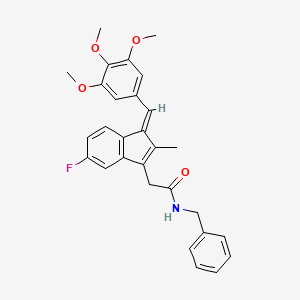

![8-hydroxy-5-[(1R)-1-hydroxy-2-[2-[4-(4-methoxy-3-phenylanilino)phenyl]ethylamino]ethyl]-1H-quinolin-2-one;hydrochloride](/img/structure/B1663498.png)
